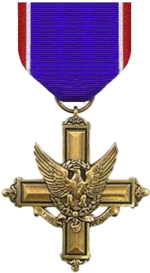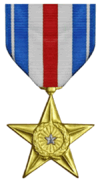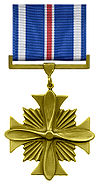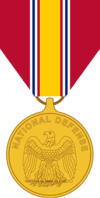|
Awards and decorations of the Vietnam War
Awards and decorations of the Vietnam War were military decorations which were bestowed by the major warring parties that participated in the Vietnam War. North Vietnam, South Vietnam, Australia, New Zealand and the United States all issued awards and decorations to their personnel during, or after, the conflict. South Vietnam as a country ceased to exist after North Vietnam's victory in the Vietnam War. Therefore, the country of South Vietnam's awards and decorations are considered obsolete.[according to whom?] With the fall of South Vietnam, that country's official records of who received which awards disappeared. Records or evidence of awards were sometimes maintained by U.S. military units or in an award recipient's service record, so those may be available to an award recipient looking for confirmation of a (defunct) foreign country award received. Despite being obsolete, earned foreign South Vietnam decorations and awards remain authorized for US military members who received awards. If an award recipient no longer possesses an original award, companies or individuals have available for purchase South Vietnam's military insignia and awards. South VietnamSenior leadership decorationsHeroism decorationsCommon decorationsUnit citations
Other awardsNorth Vietnam
Several decorations (Distinguished Flying Cross, Bronze Star Medal, Air Medal, Commendation Medal, Joint Service Commendation Medal) may be awarded for valor, or for merit. Awards for valor recognize bravery in action against an enemy and have an attached "V" device valor device. Awards for merit recognize service. The Commendation Medal was another decoration of the Vietnam War, issued frequently in various versions by the different branches of the US armed forces. Australia and New ZealandAustralia and New Zealand awarded British and Commonwealth orders and decorations to their servicemen in Vietnam, including the Distinguished Service Order and the Military Cross Australia and New Zealand jointly developed and instituted the Vietnam Medal (though separate Royal Warrants were issued). The obverse of the medal displays an effigy of Queen Elizabeth II, the reverse shows a man standing between two spheres, a symbolic representation of the ideological struggle. The ribbon incorporates the colours of the three armed services (red, navy blue, and sky blue), and the national colours of Vietnam (red and yellow). In 1992, Australia struck the Vietnam Logistic and Support Medal. The medal was intended to recognise the Australian servicemen and civilians who provided support for Australian troops. The qualifying criteria for the Medal are service of one day or more as a member or crew of a ship or aircraft operating in the prescribed area of operations of Vietnam in support of Australian forces, or service of one day or more within the prescribed area of operations of Vietnam while attached to a unit or organisation in support of Australian forces. It has been awarded to military personnel, Qantas crews, civilian medical personnel, and Embassy staff. Australia awarded four Victoria Crosses during the Vietnam War, two posthumously. Australian servicemen were also awarded a number of individual US and South Vietnamese awards, and the following unit citations:
References
External links |























